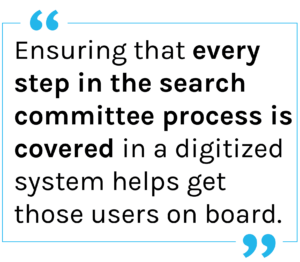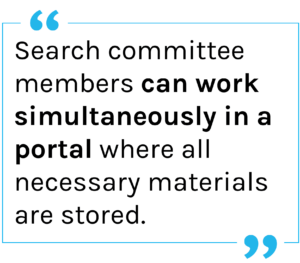How to make search committees faster and more effective in selecting key hires

Search committees have long been part of the hiring process for roles across colleges and universities, especially for faculty and for senior administrative leadership positions. Creating effective search committees can be difficult, but search committees don’t necessarily mean your hiring process has to be less efficient, effective, and streamlined.
Success with search committees comes down to having the right tools. This can be a tough ask. Some institutions have had manual search committee processes in place for so long that teams are resistant to change—but with customizable tools and the right tactics, you can drive adoption at your institution and make search committees part of a truly efficient recruitment process.
Increasing adoption by involving search committee members in the decision-making process
As colleges and universities have embraced digitization, modern recruitment marketing tools, and technologies that empower talent acquisition, some human resources departments have encountered skepticism or resistance from faculty and from others who are concerned about search committee processes.
At the University of Alabama Birmingham, Janice Ward, Faculty Affairs Manager, faced this resistance from faculty, along with rumors that the Applicant Tracking System her team was implementing would completely replace search committee meetings. As her team sought faculty buy-in, they recognized a few key components that were required for her institution to fully embrace a new talent acquisition technology.
 First, Janice asked her faculty search committees about their processes. “We brought faculty into user groups and asked them, ‘What do you think? Here’s what we are thinking about doing. Here’s how other institutions use it,’” Janice said. “We were very deliberate and purposeful in reaching out to different departments and ensuring we could meet their needs.”
First, Janice asked her faculty search committees about their processes. “We brought faculty into user groups and asked them, ‘What do you think? Here’s what we are thinking about doing. Here’s how other institutions use it,’” Janice said. “We were very deliberate and purposeful in reaching out to different departments and ensuring we could meet their needs.”
This is a vital first step in implementing a piece of technology to support your search committees: understanding what support they need. There are so many different aspects to a search committee’s process, which is what can make it so complex and sometimes slow-moving. Ensuring that every step in that process is covered in a digitized process helps get those users on board.
Demonstrate the benefits
When working to get search committee members on board with new tools, it’s important to show them the day-to-day benefits: how they can do the same task as before, but much more quickly and easily. At the University of Alabama, Janice noted a few vital benefits that helped to get faculty on her side.
One suggestion that was a clear benefit for users was building auto-generated email templates. “If creating an applicant email that relays the message ‘We are not interested, but thanks for applying’ helps to get biology department search chairs to use the system, then we create those customized emails for them in the system,” said Janice. “It takes a little work on the front end, but it’s worth it because they use it and like it.”
Another suggestion that arose from the University of Alabama’s experience: school-specific evaluation criteria. “For example, if the school of nursing has a standard set of questions that they want all of their candidates to be evaluated on, whoever’s doing the requisition can go and choose school of nursing, and it is already done for them,” noted Janice. “This makes their lives easier and helps get them engaged, especially in departments where there is a huge number of applicants, because it may weed out the 200 out of 275 applicants who don’t meet the minimum qualifications.”
With capabilities like these, it’s easy to show a search committee that digitizing won’t hinder their work—instead, it will help them level up.
Centralizing committee work
One further benefit of digitizing search committee work is the centralization of all documents, notes, and meetings. Resumes, reference letters, and interview notes no longer need to be tracked down or emailed back and forth—instead, search committee members can work simultaneously in a portal where all necessary materials are stored.
Final thoughts
Don’t give up on search committee work as a pain point that will always be complicated or slow-moving. Using a digitized applicant tracking software that was specifically built for the complexities of HigherEd, including search committee workflows, can make all the difference—and PeopleAdmin can help! Check out our Applicant Tracking System or talk to our experts for more information.